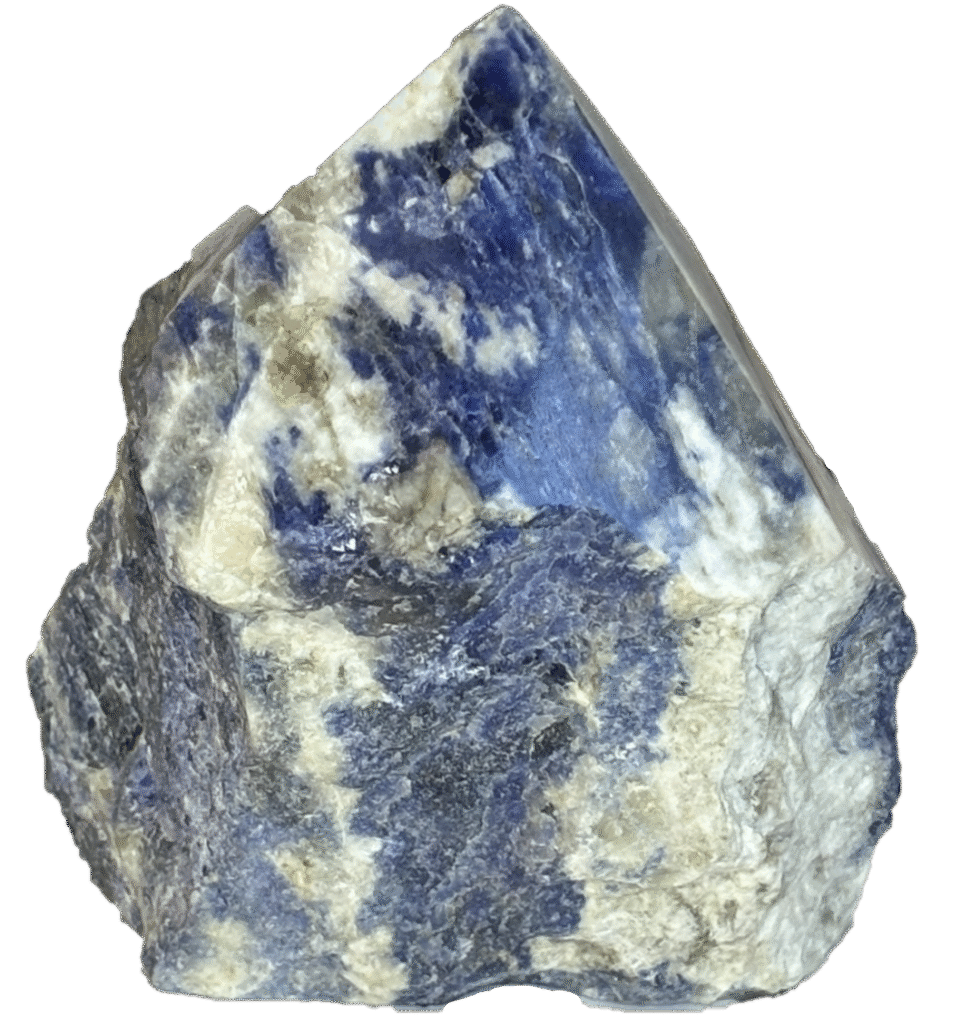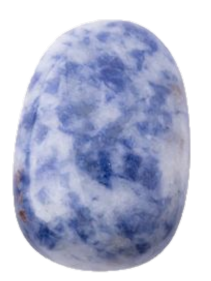
Sodalite, with its rich blue hues interlaced with streaks of white, is a captivating gemstone admired for its beauty, symbolic meaning, and metaphysical properties. Known as the “Stone of Intuition,” it has inspired awe and reverence for centuries. This article explores its fascinating origins, characteristics, and its role in history, spirituality, and culture.
Origins of Its Name and Alternate Names
The name “Sodalite” originates from the Latin words sodium and lithos, which mean “salt” and “stone,” respectively. This reflects its high sodium content, a defining characteristic of the mineral.
Sodalite is sometimes referred to as “Princess Blue” or “Canadian Blue Stone,” referencing its regal appearance and notable deposits in Canada. In metaphysical circles, it is often called the “Logic Stone” or the “Poet’s Stone” for its ability to enhance clarity and creativity.
Composition and Physical Characteristics
Sodalite is a member of the feldspathoid mineral group, with the chemical formula Na₈(Al₆Si₆O₂₄)Cl₂. Its deep blue colour, sometimes flecked with white calcite veins, sets it apart from other gemstones.
Physical Characteristics and Varieties
- Appearance: Predominantly blue with white or grey streaks, but can also exhibit shades of grey, green, or yellow.
- Lustre: Vitreous, with a soft, glass-like sheen.
- Hardness: Measures 5.5 to 6 on the Mohs scale, making it suitable for jewellery and decorative items.
- Structure: Crystalline, with a cubic symmetry.
Varieties of Sodalite include:
- Hackmanite: A rare, sulphur-rich variety that exhibits tenebrescence (changes colour under UV light).
- Blue Sodalite: The most common variety, known for its striking blue hue.
- Green Sodalite: Contains traces of other elements, lending it a greenish tint.
Geographical Locations
Sodalite is found in igneous rock formations, often in association with other feldspathoid minerals. Major sources include:
- Canada: Particularly in Ontario and British Columbia, known for high-quality deposits.
- Brazil: A significant exporter of richly coloured Sodalite.
- Russia: Known for deep blue specimens mined in the Kola Peninsula.
- United States: Found in Arkansas, Maine, and Montana.
- Afghanistan: Renowned for producing rare and vibrant pieces.
Historical Usage and Archaeological Finds
Sodalite has been appreciated since ancient times, although its official classification as a mineral only occurred in 1811. Archaeological discoveries suggest that Sodalite was used by early civilisations for ornamental purposes, particularly in South America.
One of the most notable historical uses of Sodalite is in the creation of decorative art and ceremonial objects. The Inuit people of Canada used Sodalite to carve figures and amulets, believing the stone held protective energy. In modern times, Sodalite has become a popular choice for jewellery, sculptures, and even as an architectural stone.
Interesting Facts
- Sodalite was first discovered in Greenland in 1811, though significant deposits in Canada gained worldwide attention in the late 19th century.
- The name “Princess Blue” originated when it became a favourite gemstone of Princess Patricia of Connaught, the granddaughter of Queen Victoria.
- Some specimens exhibit fluorescence, glowing under ultraviolet light.
Folklore, Superstition, Legends, and Tales
Sodalite has a rich legacy in folklore and spiritual traditions. In ancient beliefs, it was associated with the power of intuition and communication, making it a favourite stone for orators and writers.
Legends from Arctic regions suggested that Sodalite could connect the wearer with the spiritual energy of the aurora borealis (northern lights). Its luminescent blue hue was seen as a reflection of the sky’s divine energy.
In metaphysical lore, Sodalite is referred to as the “Wisdom Stone,” believed to enhance self-awareness and stimulate logical thought. It was used as a protective talisman to ward off negative energies, especially during travel.
Mystical Healing Properties
Sodalite is highly regarded for its calming and clarifying energy, making it a popular choice in holistic healing:
- Emotional Healing: Helps reduce fear, anxiety, and self-doubt, fostering inner peace and confidence.
- Physical Healing: Thought to support the immune system, regulate blood pressure, and promote hydration.
- Spiritual Healing: Facilitates meditation, heightens intuition, and improves clarity in decision-making.
Astrological Links and the Chakra System
Sodalite is closely linked to the Throat Chakra, enhancing communication and self-expression. It is also associated with the Third Eye Chakra, fostering intuition and insight.
Astrologically, Sodalite resonates with Sagittarius, a sign known for its adventurous and philosophical nature. Its energy complements Sagittarius traits, promoting clarity and intellectual exploration.
Use as a Birthstone and Wedding Anniversary Gift
While not officially recognised as a birthstone, Sodalite is a meaningful alternative for those seeking clarity, wisdom, and balance.
As a wedding anniversary gift, Sodalite symbolises trust, communication, and harmony, making it a thoughtful present for couples strengthening their bond.
Sodalite’s timeless elegance and profound symbolism make it a cherished stone for personal and spiritual growth. Whether used in jewellery, as a meditation aid, or simply admired for its beauty, this gemstone continues to inspire and captivate.

Sodalite
Sodalite deepens intuition, calms the mind, and encourages truth. A harmonising stone for insight, self-expression, and emotional clarity.
